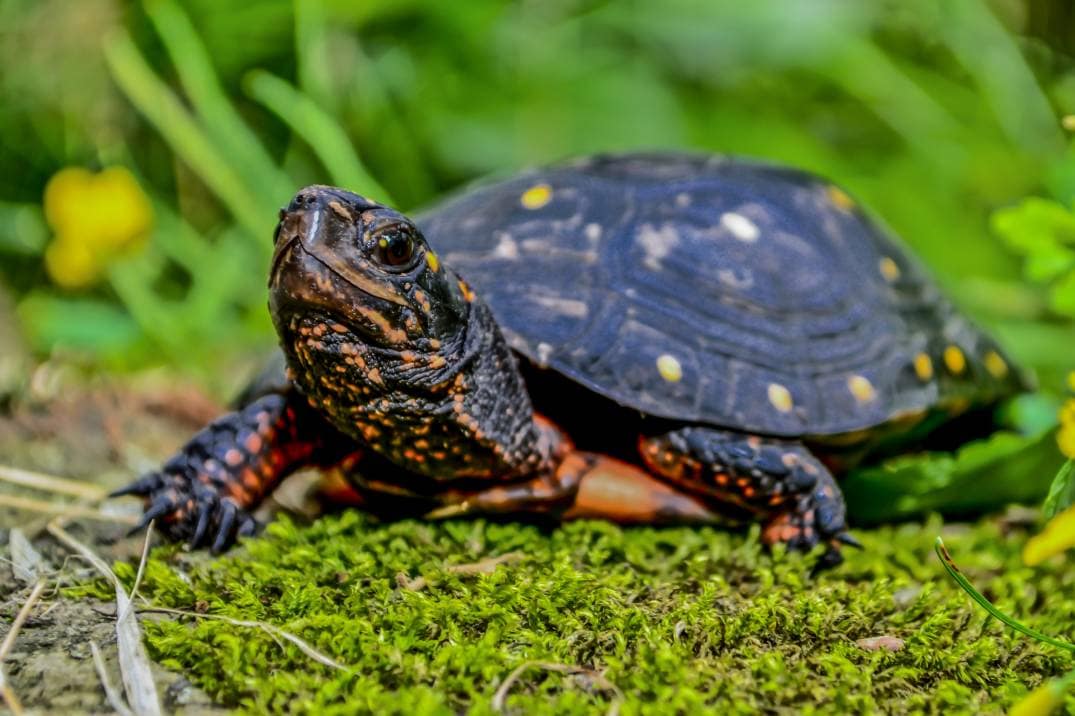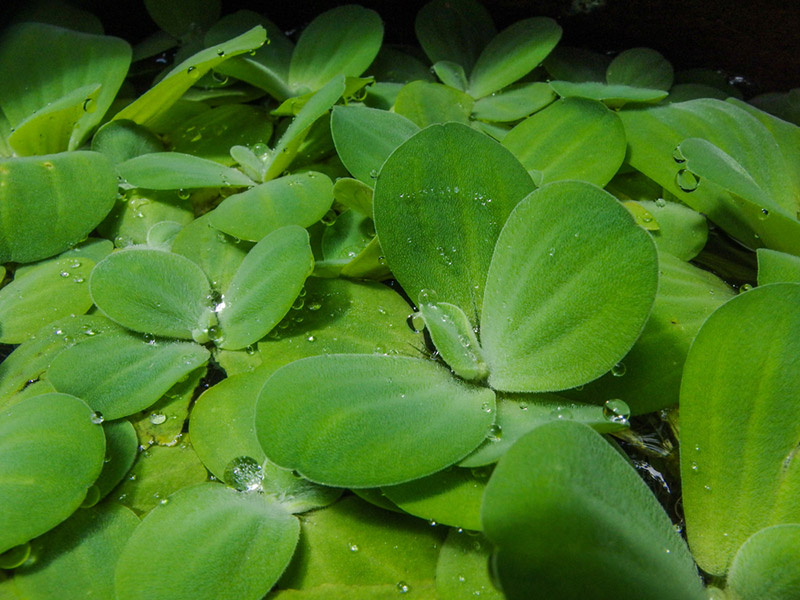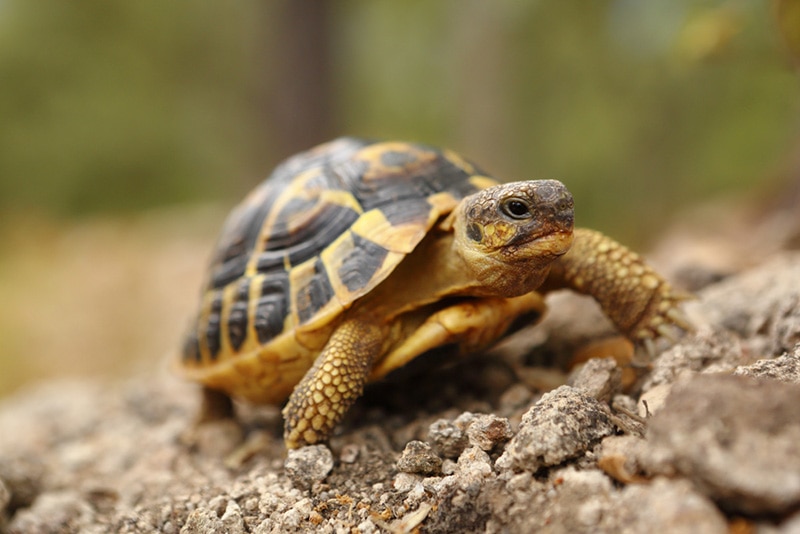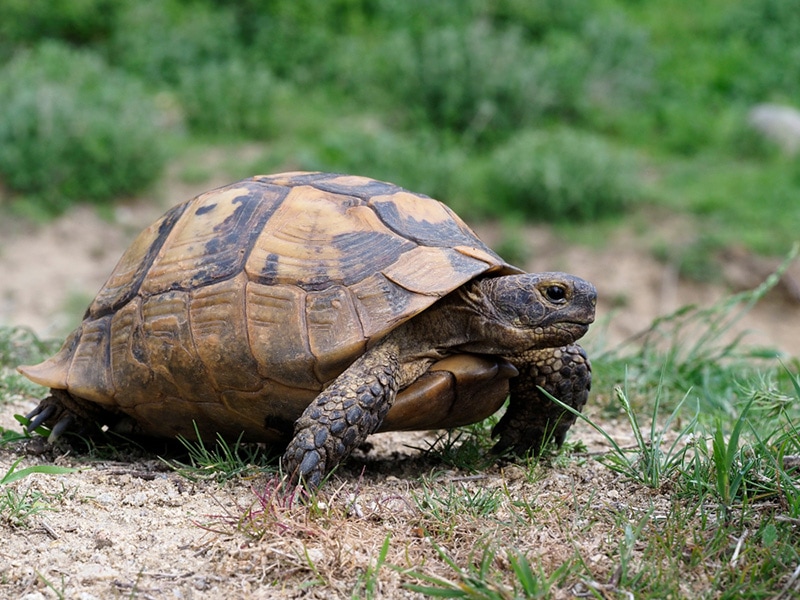Spotted Turtle: Pictures, Facts, Diet & Care Guide
Updated on

Click to Skip Ahead
Spotted Turtles are North American native turtles well-suited to captivity; however, this is not a pet for a beginner. Turtles, regardless of breed, require very particular husbandry to thrive. If you’re considering adopting one, you must educate yourself well to provide the best care for your new pet. And you’re in luck because we’ll review everything you need to know about Spotted Turtles, including how to care for them. Read on for more.
| Size: | 4.5–5 inches |
| Weight: | 1/2 to 3/4 pounds |
| Lifespan: | 50+ years |
| Suitable for: | Experienced turtle owners |
| Temperament: | Curious, skittish, alert |
Spotted Turtles are a semi-aquatic breed often found in shallow and slow-moving freshwater habitats. It’s not unusual to find them living in swamps, bogs, wet pastures, and marshes. Wild Spotted Turtles’ range extends from Michigan, southern Ontario, and Maine south to Florida. Approximately 6% of the entire global population of Spotted Turtles is in Canada; however, their abundance has significantly declined over the past several years.1
Spotted Turtle Breed Characteristics
How Much Do These Turtles Cost?
Spotted Turtles are available in a wide price range from $100 to $600, depending on where you’re sourcing them from. Other factors that can influence the cost of your turtle include its age, size, gender, appearance, and overall health. Turtles with imperfections may be available at a reduced rate.
If you’re on a tight budget, you may be able to find surrendered Spotted Turtles at your local humane society or animal shelter. Remember, however, that the setup for these animals is extremely pricey, so this isn’t a pet you should adopt if you don’t have the budget to upkeep its environment.
You should never help yourself to a wild-caught turtle. Captive-bred options are much more well-tempered and sociable, not to mention less likely to carry diseases and bacteria.

Spotted Turtle Breed Behavior
Spotted Turtles are interesting reptiles. They’re often on a reverse schedule as other turtle species in the wild. They can be fully active during periods of cold temperatures but then inactive when the temperatures are warmest. It’s not unusual to see wild Spotted Turtles basking during cool weather.
Spotted Turtles are an active and curious species. They can be skittish and frightened easily, so most don’t care to be handled and prefer being left alone. This doesn’t mean you can’t interact with your reptile, however. You just shouldn’t expect your interactions to look the same for your turtle as they do with your other household pets. A great way to bond with your reptile is to hand-feed him.
Do These Turtles Make Good Pets?
Spotted Turtles can make great pets for the right keeper. They have unique and specific care requirements, so we wouldn’t recommend owning this species unless you’re already familiar with how to care for them properly.
Spotted Turtle Tank Mates
Spotted Turtles can live together, but you must exercise caution. Keeping males together is generally not recommended as they can become aggressive toward one another. Keeping an opposite-sex pair can also lead to issues, as males often harass females with mating attempts.

Care Sheet & Habitat Setup:
Light Requirements
Spotted Turtles are a diurnal species, meaning they’re most active during daylight hours. Because your turtle will be kept indoors, you’ll need to provide exposure to both bright and UVB light during the day to ensure he gets what he needs to stay healthy.
We recommend putting your lighting on timers so you don’t need to turn them on and off manually. Leave the lights on for 14 hours daily during the summer months. Lower light exposure levels to 10 hours per day during the winter to replicate what your turtle would experience in the wild.
UVB lighting can be a challenge to get right because the strength of the UVB will depend on the distance of the light source to your pet. Place the UVB lighting primarily over the land area of the tank and aim for it to be around 12 inches over your pet’s back as he’s basking.
Unfortunately, UVB doesn’t provide enough bright light to replicate daylight. To combat this, you must supplement with a LED lamp or plant bulbs to ensure your turtle gets the required lighting.
You must also invest in a halogen heat lamp to ensure your turtle’s basking platform is at the correct temperature, anywhere between 86–90°F (30–32°C).
Tank Size
Spotted Turtles need a tank big enough to provide enough space to perform biological functions like thermoregulation and exploration. The minimum enclosure size should be 36″L x 18″W x 12″H, but you can go larger if your space allows.

Water Temperature
Spotted Turtles are cold-blooded, meaning they need to move between areas of differing temperatures to regulate their body temperature. Wild turtles can warm themselves up by moving out of the water to bask in the sunlight, so you’ll need to recreate such an environment in your pet’s tank.
The water temperature in your turtle’s tank should be between 70–84°F (21–29°C). You can measure this by using a submersible digital probe thermometer. If you need to use a water heater to reach the proper temperature, ensure it’s always covered by water. If the water evaporates to the point where the heater components are exposed to air, overheating may occur and put your turtle at risk.
Plants
You don’t need to keep live plants in your turtle’s enclosure, but they can act as environmental enrichment, hiding spots, and food, so it’s worthwhile considering. The best plants to consider include:
- Duckweed
- Pothos
- Anacharis
- Potamogeton
- Cabomba
- Java fern
- Anubias
- Hornwort
Note: If opting for artificial plants, they must be extremely sturdy, as your turtle is likely to try eating them.

Substrate
Substrate refers to the material used to line the bottom of your turtle tank. The best options include washed play sand or aquarium sand. Gravel and pebbles generally aren’t recommended as they’re easy to accidentally ingest and can make your pet sick.
Spotted Turtles are not as strong at swimming as other aquatic turtles, so they spend much of their time on land. Approximately 50% of your turtle’s enclosure should include an easily accessible land area.
Filtration
Aside from keeping your turtle’s water at the correct temperature, it must always be kept clean. You’ll need to invest in a high-quality filtration system. A canister-style filter is recommended. It should be able to handle at least twice or three times the amount of water in the tank because turtles are very messy.
Of course, filtration alone won’t be enough to keep your turtle’s tank clean. You’ll need to remove and replace approximately 30% of his water weekly or bi-weekly to prevent potentially toxic build-ups from forming.

Things to Know When Owning a Spotted Turtle:
Food & Diet Requirements
Spotted Turtles are omnivores, meaning they require a diet of both plant and animal material to get their required nutrients. The animal/plant ratio you’ll need to feed will depend on your turtle’s age.
Those younger than six months should eat an equal mix of protein and veggies and be offered pellets daily. Those between six and 12 months should maintain that 50/50 mix of protein and vegetables but scale back their pellets to once every two days. Fully grown Spotted Turtles will require much less protein and more veggies. Aim for a 25% protein and 75% vegetable diet, with pellets offered twice or thrice weekly.
The key to feeding your Spotted Turtle the most nutritious diet is providing much variety. You wouldn’t want to eat the same things every day, nor does your turtle.
The best protein options include:
- Crickets
- Locusts
- Dubia roaches
- Freeze-dried shrimp
- Silkworms
- Snails
- Hornworms
The best plant material includes:
- Dandelion greens
- Dandelion flowers
- Collard greens
- Green leaf lettuce
- Kale
- Romaine
Your turtle’s pellets should provide the remaining nutrients your pet needs to thrive; however, you’ll need calcium supplementation. A cuttlebone is preferred over calcium powders as you’ll find your turtle likely prefers eating in his water than on land.
Size & Growth Chart
Spotted turtles are a small species, growing to be just 4.5 to 6 inches long and around ½ to ¾ pounds.

Lifespan & Health Conditions
Spotted Turtles are generally considered robust reptiles, but they may be prone to developing certain health conditions if not taken care of appropriately. The right diet, lighting, and heating setup will ensure your pet stays happy and healthy as long as possible.
The most common conditions of pet turtles include vitamin A deficiency, respiratory disorders, shell infections, shell fractures, and parasites. They may also be at risk of developing eye issues, diarrhea, abscesses, overgrown claws and beaks, and metabolic bone disease.
- Parasites
- Diarrhea
- Eye issues
- Overgrown claws or beaks
- Vitamin A deficiency
- Respiratory infections
- Shell problems
- Metabolic bone disease
Male vs. Female
Several key physical characteristics develop around the time of sexual maturity that set female and male Spotted Turtles apart.
Females are typically larger than their male counterparts and have more spots on average. Their shells are more domed, and they have yellow chins and orange eyes. Males have a tan chin with brown eyes. Their tails are longer and thicker than females. Additionally, the bottom shell of male Spotted Turtles is concave, while females are flat or convex.
3 Little-Known Facts About The Spotted Turtle
1. Spotted Turtles can have many or barely any spots at all.
This species’ most defining characteristic – its spots – can vary greatly. Some will have hundreds of spots, while others will have none at all. It’s been found that the left side of the upper shell always has more spots than the right.
2. Spotted Turtles are endangered in some regions.
The Spotted Turtle is federally endangered in Canada. They are a Species of Greatest Conservation Need in all the 12 American states they occur. Habitat loss and conservation, illegal pet trade collection, and other human impacts are the leading causes of the decline of the Spotted Turtle population. Vehicular mortality is quite impactful as many turtles that are hit while crossing the road are likely pregnant females looking for an adequate nesting site.

3. Owners of Spotted Turtles may need to facilitate hibernation annually.
Hibernation is crucial to the health and well-being of your Spotted Turtle. You may need to help your turtle go into hibernation and act as a facilitator during the process. Only healthy turtles should hibernate, so you must take your turtle to the vet beforehand to ensure he is well enough to hibernate. Your exotic vet can then provide details on facilitating the hibernation process to ensure your turtle comes out healthy at the end of the season.
Final Thoughts
Spotted Turtles are a great pet for experienced turtle owners. Their specific care requirements, especially regarding their lighting, water, and temperature needs, mean they need an owner well-versed in reptile keeping.
Find a reputable breeder or rescue organization to adopt from, and never seek out a wild turtle to bring home as a pet. Captive-bred reptiles will not only likely be friendlier than their wild counterparts and less likely to harbor dangerous diseases, but you’ll also be doing your part to preserve the dwindling wild populations.
Read Also:
- Are Turtles Good Pets? Reason, Facts & FAQ
- Tortoise vs. Turtle: Differences & Comparison (With Pictures)
Featured Image Credit: Jay Ondreicka, Shutterstock












